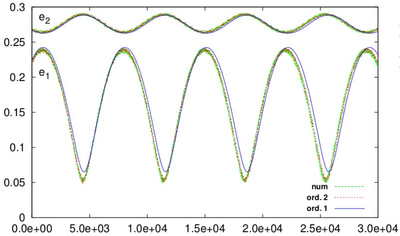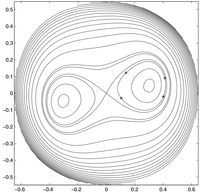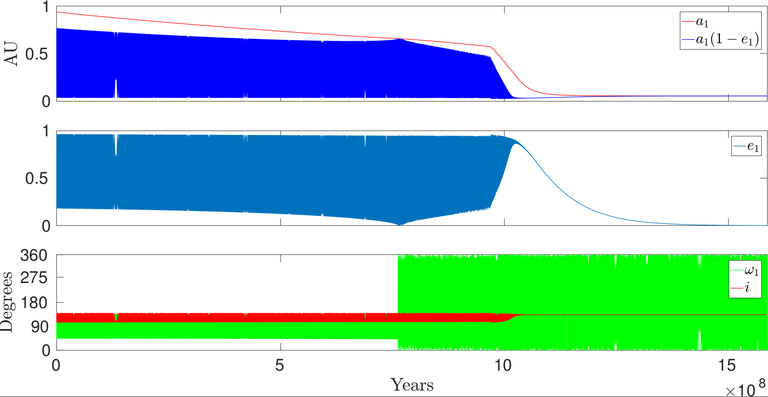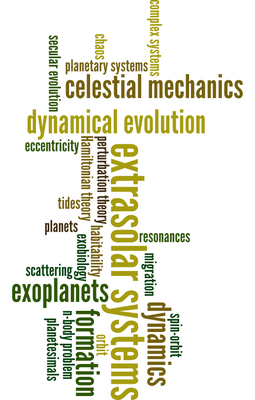Evolution
SECULAR EVOLUTION OF PLANETARY SYSTEMS
In contrast to the quasi-circular planetary orbits of the Solar System, the exoplanets usually describe true ellipses with high eccentricities. The classical Laplace-Lagrange perturbation theory uses the circular approximation as a reference and can thus be doubtful for these systems. Perturbation theory reveals very efficient for describing the long-term evolution of the extrasolar systems.
 We have shown that the generalization of the Laplace-Lagrange theory based on a high-order expansion of the perturbative potential is able to describe the secular dynamics of both coplanar and three-dimensional two-planet non-resonant systems (Libert & Henrard 2005, 2007). As the spatial resolution of the detected systems is currently not possible due to the limitations of the detection methods, we have highlighted that stable highly non-coplanar systems can exist, either following normal secular dynamics or due to the action of a phase-protection mechanism like the Kozai resonance. This analytical prediction seems in agreement with the detection of McArthur et al. (2010) that estimated to ~30° the mutual inclination of planets c and d of Upsilon Andromedae system.
We have shown that the generalization of the Laplace-Lagrange theory based on a high-order expansion of the perturbative potential is able to describe the secular dynamics of both coplanar and three-dimensional two-planet non-resonant systems (Libert & Henrard 2005, 2007). As the spatial resolution of the detected systems is currently not possible due to the limitations of the detection methods, we have highlighted that stable highly non-coplanar systems can exist, either following normal secular dynamics or due to the action of a phase-protection mechanism like the Kozai resonance. This analytical prediction seems in agreement with the detection of McArthur et al. (2010) that estimated to ~30° the mutual inclination of planets c and d of Upsilon Andromedae system.
For systems that are near a mean-motion resonance, we have shown that an extension of the Laplace-Lagrange theory to order two in the masses is required to describe accurately their secular evolution (Libert & Sansottera 2013). In these works, we have determined the fundamental frequencies of the motion and computed precisely the long-term evolution of the Keplerian elements with a totally analytical method, based on Lie transforms.
Finally, for systems that are really close to or in a mean-motion resonance, a resonant model has to be used. We show how the long-term evolution can accurately be reproduced by including appropriate resonant combinations of the fast angles into the Laplace-Lagrange expansion.
More information:
Libert, A.-S., Henrard, J., Analytical approach to the secular behaviour of exoplanetary systems, Celestial Mechanics & Dynamical Astronomy, 2005, volume 93, issue 1-4, pp. 187-200
Libert, A.-S., Henrard, J., Exoplanetary systems : The role of Libert, A.-S., Henrard, J., Exoplanetary systems : The role of an equilibrium at high mutual inclination in shaping the global behaviour of the 3-D secular planetary three-body problem, Icarus, 2007, volume 191, issue 2, pp. 469-485
Libert, A.-S., Sansottera, M., On the extension of the Laplace-Lagrange secular theory to order two in the masses for extrasolar systems, Celestial Mechanics and Dynamical Astronomy, 2013, volume 117, issue 2, pp. 149-168
DYNAMICAL CONSTRAINTS ON THE OBSERVATIONS
To date, about 3000 confirmed planets have been catalogued (plus over 2000 planet candidates of the Kepler mission), and we count more than 400 multi-planetary systems. However, due to the limitations of the detection methods, some of the orbital elements of these planets are currently unknown or poorly constrained. In particular, we focus on two-planet systems detected via the radial velocity method. We aim to find ranges of values of the unknown masses and orbital elements (i.e., the inclinations in our case) which are compatible with the well determined orbital parameters (i.e. both the semi-major axes and the eccentricities) and ensure the long-term stability of the system.
On the one hand, we have reversed the usual approach about the possible applications of KAM theory in celestial mechanics, in order to have a better understanding of the dynamics in multi-planetary extrasolar systems. Instead of applying the KAM theory to well constrained simplified models of our Solar system, we have assumed that the known extrasolar systems are stable in KAM sense and deduced the range of values of both inclinations and masses which are compatible with their stability (Volpi et al. 2018).

On the other hand, to supplement a preliminary numerical study (Libert & Tsiganis 2009), we have adopted a semi-analytical approach, based on the Laplace-Lagrange secular hamiltonian developped to high order in eccentricities and inclinations. We have performed an extensive parametric study to determine the configurations of RV-detected two-planet systems compatible with a Lidov-Kozai resonant state. Chaotic indicators have also been used to produce maps of stability for the different systems and determine stability zones in the parameter space that are compatible with the long-term stability of the system. As a by-product of this study, we have shown that the hamiltonian approach is valid up to very high mutual inclinations (~80°).
More information:
Libert, A.-S., Tsiganis, K., Kozai resonance in extrasolar systems, Astronomy & Astrophysics, 2009, volume 493, issue 2, pp. 677-686
Volpi, M., Locatelli, U., Sansottera, M., A reverse KAM method to estimate unknown mutual inclinations in exoplanetary systems, Celestial Mechanics and Dynamical Astronomy, 2018, submitted
Dynamical evolution of triple-star systems
Many triple-star systems have an inner orbital period of a few days only. A common mechanism to explain the three-day pile-up present in the observations is the Lidov-Kozai cycles combined with tidal friction. Using the hierarchical three-body problem (octupole order approximation), with the effects of tides, stellar oblateness, general relativity and magnetic spin-down of the inner binary, we aim to determine which initial values of the orbital elements initiate the Lidov-Kozai migration and the subsequent formation of the three-day pile-up.

Fundings:
- F.R.S.-FNRS ExtraOrDynHa (Extrasolar Orbital Dynamics and Habilitability) Research Project (2013-2017, Grant No. T.0029.13)
- FRIA STAB_EXTRA Research fellowship (2015-2019)
- Computational resources were provided by the Consortium des Équipements de Calcul Intensif (CÉCI), funded by the Fonds de la Recherche Scientifique de Belgique (F.R.S.-FNRS) under Grant No. 2.5020.11.










